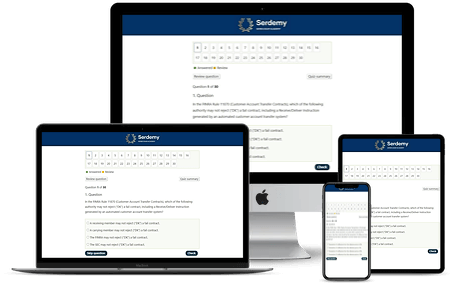Quiz-summary
0 of 30 questions completed
Questions:
- 1
- 2
- 3
- 4
- 5
- 6
- 7
- 8
- 9
- 10
- 11
- 12
- 13
- 14
- 15
- 16
- 17
- 18
- 19
- 20
- 21
- 22
- 23
- 24
- 25
- 26
- 27
- 28
- 29
- 30
Information
Premium Practice Questions
You have already completed the quiz before. Hence you can not start it again.
Quiz is loading...
You must sign in or sign up to start the quiz.
You have to finish following quiz, to start this quiz:
Results
0 of 30 questions answered correctly
Your time:
Time has elapsed
Categories
- Not categorized 0%
- 1
- 2
- 3
- 4
- 5
- 6
- 7
- 8
- 9
- 10
- 11
- 12
- 13
- 14
- 15
- 16
- 17
- 18
- 19
- 20
- 21
- 22
- 23
- 24
- 25
- 26
- 27
- 28
- 29
- 30
- Answered
- Review
-
Question 1 of 30
1. Question
An assessment of a customer dispute involving a registered independent Introducing Broker (IB) and its clearing Futures Commission Merchant (FCM) reveals the following facts. The IB does not have a guarantee agreement with the FCM. A customer, introduced to the FCM by the IB, has filed a formal complaint alleging that an Associated Person at the IB excessively traded, or churned, their account to generate commissions. The FCM properly executed all trades as instructed by the IB, held the customer’s funds, and sent all required statements and confirmations. Given these circumstances and according to NFA and CFTC rules, what is the most likely determination regarding the FCM’s liability for the alleged churning?
Correct
The core of this issue lies in the distinction between a guaranteed introducing broker and an independent introducing broker under the regulations of the Commodity Futures Trading Commission (CFTC) and the National Futures Association (NFA). When a Futures Commission Merchant (FCM) enters into a formal guarantee agreement with an Introducing Broker (IB), the FCM becomes jointly and severally liable for all obligations of that IB arising from its activities as an IB. This effectively means the FCM is legally responsible for the actions, errors, and omissions of the guaranteed IB and its associated persons as if they were its own employees. However, the scenario specifies that there is no guarantee agreement in place. This makes the introducing broker an independent IB. In such a relationship, the FCM’s primary roles are to execute and clear trades, hold customer funds, issue confirmations and statements, and perform its own direct supervisory duties over the accounts it carries. The FCM is not, by default, vicariously liable for the separate fraudulent acts, such as churning, committed by the employees of an independent IB. The liability for such misconduct rests with the independent IB itself and the associated person who committed the violation. Unless it can be demonstrated that the FCM was itself negligent in its duties, for example, by failing to notice and act upon blatant and obvious signs of churning reflected in the account statements it was generating, it would not be held responsible for the independent IB’s fraudulent behavior. Therefore, the regulatory liability for the churning would fall upon the independent IB, not the clearing FCM.
Incorrect
The core of this issue lies in the distinction between a guaranteed introducing broker and an independent introducing broker under the regulations of the Commodity Futures Trading Commission (CFTC) and the National Futures Association (NFA). When a Futures Commission Merchant (FCM) enters into a formal guarantee agreement with an Introducing Broker (IB), the FCM becomes jointly and severally liable for all obligations of that IB arising from its activities as an IB. This effectively means the FCM is legally responsible for the actions, errors, and omissions of the guaranteed IB and its associated persons as if they were its own employees. However, the scenario specifies that there is no guarantee agreement in place. This makes the introducing broker an independent IB. In such a relationship, the FCM’s primary roles are to execute and clear trades, hold customer funds, issue confirmations and statements, and perform its own direct supervisory duties over the accounts it carries. The FCM is not, by default, vicariously liable for the separate fraudulent acts, such as churning, committed by the employees of an independent IB. The liability for such misconduct rests with the independent IB itself and the associated person who committed the violation. Unless it can be demonstrated that the FCM was itself negligent in its duties, for example, by failing to notice and act upon blatant and obvious signs of churning reflected in the account statements it was generating, it would not be held responsible for the independent IB’s fraudulent behavior. Therefore, the regulatory liability for the churning would fall upon the independent IB, not the clearing FCM.
-
Question 2 of 30
2. Question
An Associated Person (AP) at a guaranteed Introducing Broker (IB) creates a new marketing brochure intended for prospective clients. An assessment of the brochure’s content reveals several statements and features. Which of the following elements within the brochure would constitute a clear violation of NFA Compliance Rule 2-29 concerning promotional material?
Correct
NFA Compliance Rule 2-29 governs the creation and distribution of promotional material by NFA members, including Introducing Brokers and their Associated Persons. The rule’s primary objective is to ensure that all communications with the public are fair, balanced, and not misleading. A core tenet of this rule pertains to the presentation of performance results. While presenting performance is not prohibited, it is subject to strict guidelines. Specifically, when promotional material includes hypothetical or simulated performance results, it must be accompanied by a prescribed cautionary statement. This statement must explicitly inform the reader that hypothetical performance results have inherent limitations. It should clarify that, unlike an actual performance record, simulated results do not represent actual trading. Also, since the trades have not been executed, the results may have under or over compensated for the impact, if any, of certain market factors, such as lack of liquidity. Simulated trading programs in general are also subject to the fact that they are designed with the benefit of hindsight. The rule mandates that no representation is being made that any account will or is likely to achieve profits or losses similar to those being shown. Presenting a chart of impressive hypothetical returns without this specific, required disclaimer is a direct violation because it creates a misleading impression of potential profitability and omits the necessary context about the significant limitations of such data.
Incorrect
NFA Compliance Rule 2-29 governs the creation and distribution of promotional material by NFA members, including Introducing Brokers and their Associated Persons. The rule’s primary objective is to ensure that all communications with the public are fair, balanced, and not misleading. A core tenet of this rule pertains to the presentation of performance results. While presenting performance is not prohibited, it is subject to strict guidelines. Specifically, when promotional material includes hypothetical or simulated performance results, it must be accompanied by a prescribed cautionary statement. This statement must explicitly inform the reader that hypothetical performance results have inherent limitations. It should clarify that, unlike an actual performance record, simulated results do not represent actual trading. Also, since the trades have not been executed, the results may have under or over compensated for the impact, if any, of certain market factors, such as lack of liquidity. Simulated trading programs in general are also subject to the fact that they are designed with the benefit of hindsight. The rule mandates that no representation is being made that any account will or is likely to achieve profits or losses similar to those being shown. Presenting a chart of impressive hypothetical returns without this specific, required disclaimer is a direct violation because it creates a misleading impression of potential profitability and omits the necessary context about the significant limitations of such data.
-
Question 3 of 30
3. Question
Assessment of the relationship between a guarantor Futures Commission Merchant (FCM) and its guaranteed Introducing Broker (IB) reveals specific regulatory obligations. Consider a scenario where an Associated Person (AP) employed by “Momentum Brokers,” a guaranteed IB, is found to have excessively traded a client’s account to generate commissions, an activity known as churning. The client files a formal complaint seeking damages. “Apex Clearing,” the guarantor FCM for Momentum Brokers, is notified of the complaint. Which of the following statements most accurately describes Apex Clearing’s regulatory responsibility in this situation?
Correct
Under the regulatory framework established by the Commodity Futures Trading Commission and the National Futures Association, a Futures Commission Merchant that acts as a guarantor for an Introducing Broker enters into a specific legal and financial relationship. This guarantee agreement means the FCM assumes full joint and several liability for all obligations and activities of the guaranteed IB and its Associated Persons that arise in connection with their duties as an IB. Essentially, the FCM is treating the IB’s employees and actions as if they were its own. This includes responsibility for any rule violations, such as churning, unauthorized trading, or mishandling of customer funds, committed by the IB or its APs. The FCM cannot delegate this responsibility or claim that the IB is a separate legal entity to avoid liability. Consequently, if a customer of a guaranteed IB suffers damages due to misconduct by one of the IB’s APs, the guarantor FCM is directly and financially responsible for those damages. This structure is designed to provide greater customer protection by ensuring that even small IBs are backed by the capital and supervisory structure of a larger FCM. The FCM is also responsible for diligently supervising the activities of its guaranteed IB to prevent such violations from occurring in the first place.
Incorrect
Under the regulatory framework established by the Commodity Futures Trading Commission and the National Futures Association, a Futures Commission Merchant that acts as a guarantor for an Introducing Broker enters into a specific legal and financial relationship. This guarantee agreement means the FCM assumes full joint and several liability for all obligations and activities of the guaranteed IB and its Associated Persons that arise in connection with their duties as an IB. Essentially, the FCM is treating the IB’s employees and actions as if they were its own. This includes responsibility for any rule violations, such as churning, unauthorized trading, or mishandling of customer funds, committed by the IB or its APs. The FCM cannot delegate this responsibility or claim that the IB is a separate legal entity to avoid liability. Consequently, if a customer of a guaranteed IB suffers damages due to misconduct by one of the IB’s APs, the guarantor FCM is directly and financially responsible for those damages. This structure is designed to provide greater customer protection by ensuring that even small IBs are backed by the capital and supervisory structure of a larger FCM. The FCM is also responsible for diligently supervising the activities of its guaranteed IB to prevent such violations from occurring in the first place.
-
Question 4 of 30
4. Question
The following case involves “Momentum Futures,” a Guaranteed Introducing Broker (G-IB), which is guaranteed by a large Futures Commission Merchant (FCM), “Global Clearing Corp.” An Associated Person at Momentum Futures creates a new marketing brochure that prominently features the claim of “achieving risk-free returns” through a specific commodity option strategy. A new client, Anika, opens an account based on this brochure, subsequently loses a substantial amount of her investment, and files a formal written complaint with Momentum Futures, citing the misleading brochure. Given these circumstances, what is the most accurate description of the regulatory liability and responsibilities of Global Clearing Corp., the guarantor FCM?
Correct
The core of this situation lies in the legal and regulatory structure of a guarantee agreement between a Guaranteed Introducing Broker (G-IB) and its Futures Commission Merchant (FCM). Under NFA and CFTC rules, when an FCM agrees to guarantee an IB, it assumes joint and several liability for all obligations and duties of that IB arising from its activities in the futures business. This liability is not limited to financial solvency or trade execution but extends to all regulatory compliance matters. In this scenario, the promotional material created by the G-IB contains a statement promising “risk-free returns,” which is a clear and serious violation of NFA Compliance Rule 2-29. This rule strictly prohibits any promotional material that is misleading, deceptive, or makes unbalanced statements about the potential for profit without also discussing the risk of loss. The guarantor FCM is responsible for supervising the activities of its G-IBs, including the review and approval of promotional materials. Therefore, the FCM is directly implicated in this violation through its supervisory failure. When the client files a formal written complaint, the responsibility for its handling and resolution also falls upon the guarantor FCM. While the G-IB would be involved, the FCM cannot simply delegate the issue. The FCM must ensure the complaint is handled properly, logged, and reported as required by NFA rules. The ultimate liability for the G-IB’s regulatory breach and any resulting customer harm rests with both the G-IB and, crucially, the guarantor FCM due to the guarantee agreement. The FCM cannot claim ignorance or separation from the G-IB’s actions in this context.
Incorrect
The core of this situation lies in the legal and regulatory structure of a guarantee agreement between a Guaranteed Introducing Broker (G-IB) and its Futures Commission Merchant (FCM). Under NFA and CFTC rules, when an FCM agrees to guarantee an IB, it assumes joint and several liability for all obligations and duties of that IB arising from its activities in the futures business. This liability is not limited to financial solvency or trade execution but extends to all regulatory compliance matters. In this scenario, the promotional material created by the G-IB contains a statement promising “risk-free returns,” which is a clear and serious violation of NFA Compliance Rule 2-29. This rule strictly prohibits any promotional material that is misleading, deceptive, or makes unbalanced statements about the potential for profit without also discussing the risk of loss. The guarantor FCM is responsible for supervising the activities of its G-IBs, including the review and approval of promotional materials. Therefore, the FCM is directly implicated in this violation through its supervisory failure. When the client files a formal written complaint, the responsibility for its handling and resolution also falls upon the guarantor FCM. While the G-IB would be involved, the FCM cannot simply delegate the issue. The FCM must ensure the complaint is handled properly, logged, and reported as required by NFA rules. The ultimate liability for the G-IB’s regulatory breach and any resulting customer harm rests with both the G-IB and, crucially, the guarantor FCM due to the guarantee agreement. The FCM cannot claim ignorance or separation from the G-IB’s actions in this context.
-
Question 5 of 30
5. Question
Alistair, an Associated Person at ‘Momentum Futures IB,’ is drafting a new promotional brochure aimed at attracting sophisticated investors. He wants to ensure every claim is compliant with NFA rules. Which of the following statements, intended for the brochure, would be permissible under NFA Compliance Rule 2-29?
Correct
The statement is permissible because it adheres to the principles of NFA Compliance Rule 2-29, which governs promotional material. The rule requires that all communications with the public be balanced, fair, and not misleading. This statement correctly frames a trading strategy’s objective by stating it is “designed to profit” from a specific market condition, which is a statement of intent rather than a guarantee of success. Crucially, it avoids making promissory claims or downplaying risk. Instead, it explicitly and immediately follows the description of the potential benefit with a clear disclosure of the associated danger, mentioning that “significant losses are possible if the market moves unexpectedly.” This balanced presentation of both potential reward and potential risk is the cornerstone of compliant promotional material. The rule strictly prohibits statements that guarantee profits, imply risk-free trading, or suggest that a particular strategy will be successful. It also forbids implying that regulatory oversight by the NFA or CFTC constitutes an endorsement of a firm’s trading programs or skill. Cherry-picking successful past performance without extensive disclaimers is also a violation. The permissible statement avoids all these pitfalls by being descriptive of the strategy’s purpose while being transparent about the inherent risks involved in futures and options trading.
Incorrect
The statement is permissible because it adheres to the principles of NFA Compliance Rule 2-29, which governs promotional material. The rule requires that all communications with the public be balanced, fair, and not misleading. This statement correctly frames a trading strategy’s objective by stating it is “designed to profit” from a specific market condition, which is a statement of intent rather than a guarantee of success. Crucially, it avoids making promissory claims or downplaying risk. Instead, it explicitly and immediately follows the description of the potential benefit with a clear disclosure of the associated danger, mentioning that “significant losses are possible if the market moves unexpectedly.” This balanced presentation of both potential reward and potential risk is the cornerstone of compliant promotional material. The rule strictly prohibits statements that guarantee profits, imply risk-free trading, or suggest that a particular strategy will be successful. It also forbids implying that regulatory oversight by the NFA or CFTC constitutes an endorsement of a firm’s trading programs or skill. Cherry-picking successful past performance without extensive disclaimers is also a violation. The permissible statement avoids all these pitfalls by being descriptive of the strategy’s purpose while being transparent about the inherent risks involved in futures and options trading.
-
Question 6 of 30
6. Question
An assessment of a new digital marketing campaign by “Momentum Futures,” an independent Introducing Broker, reveals several components. The campaign features a prominent headline stating, “Unlock Guaranteed Wealth with Our Proprietary Trading Signals!” It includes a video testimonial from a paid actor portraying a successful client, discussing large, hypothetical gains without any disclosure that the results are not actual. Furthermore, the detailed fee schedule, which omits exchange and NFA fees, is only accessible via a small link at the bottom of the page. Finally, the risk disclosure provided is a simplified, paraphrased version, not the verbatim text required by the CFTC. According to NFA Compliance Rule 2-29, which of these aspects constitutes the most significant violation?
Correct
NFA Compliance Rule 2-29 governs communications with the public and the use of promotional material. The foundational principle of this rule is that all such communications must be balanced, fair, and not misleading. The rule explicitly prohibits any statement that suggests futures trading is easy, that profits are guaranteed, or that minimizes the inherent risk of loss. Any mention of the possibility of profit must be accompanied by an equally prominent statement about the risk of loss. In the described scenario, the most significant violation is the combination of a headline that implies guaranteed profits and the simultaneous failure to present the substantial risk of loss with equal prominence. This directly misrepresents the fundamental nature of futures trading and is considered a major breach of the duty to communicate fairly with the public. While other issues like incomplete fee disclosures or the use of testimonials with hypothetical results are also violations, they are secondary to the primary misrepresentation of the risk and reward profile. The core purpose of Rule 2-29 is to prevent firms from luring customers with deceptive claims of high returns while obscuring the very real possibility of substantial losses. Therefore, a promotional piece that promises profits while failing to adequately disclose risks commits the most serious infraction against this rule.
Incorrect
NFA Compliance Rule 2-29 governs communications with the public and the use of promotional material. The foundational principle of this rule is that all such communications must be balanced, fair, and not misleading. The rule explicitly prohibits any statement that suggests futures trading is easy, that profits are guaranteed, or that minimizes the inherent risk of loss. Any mention of the possibility of profit must be accompanied by an equally prominent statement about the risk of loss. In the described scenario, the most significant violation is the combination of a headline that implies guaranteed profits and the simultaneous failure to present the substantial risk of loss with equal prominence. This directly misrepresents the fundamental nature of futures trading and is considered a major breach of the duty to communicate fairly with the public. While other issues like incomplete fee disclosures or the use of testimonials with hypothetical results are also violations, they are secondary to the primary misrepresentation of the risk and reward profile. The core purpose of Rule 2-29 is to prevent firms from luring customers with deceptive claims of high returns while obscuring the very real possibility of substantial losses. Therefore, a promotional piece that promises profits while failing to adequately disclose risks commits the most serious infraction against this rule.
-
Question 7 of 30
7. Question
An NFA audit uncovers that an Associated Person at “Momentum Futures,” a Guaranteed Introducing Broker (GIB), has been distributing promotional materials that contain hypothetical performance results without the required disclosures and disclaimers, a direct violation of NFA Compliance Rule 2-29. The GIB’s guarantor, “Apex Clearing,” a registered FCM, had no direct role in creating or disseminating these non-compliant materials. A client who incurred significant losses after relying on these materials files a formal complaint seeking damages from both Momentum Futures and Apex Clearing. Based on NFA rules governing the FCM-GIB relationship, what is the most accurate assessment of Apex Clearing’s responsibility?
Correct
Under the regulatory framework established by the Commodity Futures Trading Commission and the National Futures Association, a Futures Commission Merchant that acts as a guarantor for an Introducing Broker enters into a specific legal relationship with significant consequences. This relationship is defined by a guarantee agreement, which stipulates that the FCM assumes joint and several liability for all obligations of its Guaranteed Introducing Broker that arise from its activities as an IB. This liability is comprehensive and is not limited to purely financial defaults, such as the GIB’s failure to meet its own financial requirements. It explicitly extends to regulatory violations, customer complaints, and any resulting damages or restitution. Therefore, if an Associated Person of the GIB violates NFA rules, such as those governing promotional materials or just and equitable principles of trade, the guarantor FCM is held responsible as if it had committed the violation itself. The FCM’s lack of direct knowledge or involvement in the specific wrongful act does not absolve it of this liability. The purpose of this stringent requirement is to ensure that customers of a GIB, which typically has lower net capital requirements than an FCM, have recourse to a well-capitalized and regulated entity in the event of misconduct or financial failure by the IB.
Incorrect
Under the regulatory framework established by the Commodity Futures Trading Commission and the National Futures Association, a Futures Commission Merchant that acts as a guarantor for an Introducing Broker enters into a specific legal relationship with significant consequences. This relationship is defined by a guarantee agreement, which stipulates that the FCM assumes joint and several liability for all obligations of its Guaranteed Introducing Broker that arise from its activities as an IB. This liability is comprehensive and is not limited to purely financial defaults, such as the GIB’s failure to meet its own financial requirements. It explicitly extends to regulatory violations, customer complaints, and any resulting damages or restitution. Therefore, if an Associated Person of the GIB violates NFA rules, such as those governing promotional materials or just and equitable principles of trade, the guarantor FCM is held responsible as if it had committed the violation itself. The FCM’s lack of direct knowledge or involvement in the specific wrongful act does not absolve it of this liability. The purpose of this stringent requirement is to ensure that customers of a GIB, which typically has lower net capital requirements than an FCM, have recourse to a well-capitalized and regulated entity in the event of misconduct or financial failure by the IB.
-
Question 8 of 30
8. Question
A customer, Kenji, opens a futures trading account through ‘Momentum Futures Group,’ which is a registered Introducing Broker (IB). Momentum Futures Group operates under a formal, written guarantee agreement with ‘Sterling Clearing,’ a large Futures Commission Merchant (FCM). An Associated Person at Momentum Futures Group negligently enters an incorrect order quantity for Kenji’s account, resulting in a substantial financial loss. When Kenji seeks to recover his damages, what is the regulatory and legal standing of Sterling Clearing?
Correct
Conclusion: Based on CFTC and NFA regulations, the existence of a formal guarantee agreement makes the Futures Commission Merchant (FCM) jointly and severally liable for the obligations of its guaranteed Introducing Broker (IB) that arise from the IB’s activities as an IB. Therefore, the FCM is legally responsible for the financial damages caused by the IB’s employee. The structure of the futures industry allows for different types of relationships between Introducing Brokers and Futures Commission Merchants. An IB is a firm or individual that solicits or accepts orders for futures contracts but does not accept money, securities, or property to margin, guarantee, or secure any trades or contracts that result therefrom. All trades introduced by an IB must be cleared through an FCM. There are two primary types of IBs: independent and guaranteed. An independent IB must meet its own minimum net capital requirements as set by the CFTC. In contrast, a guaranteed IB does not need to meet these capital requirements because it has entered into a formal, written guarantee agreement with an FCM. This agreement is a critical regulatory construct. Under this agreement, the FCM guarantees the performance of, and is held jointly and severally liable for, all obligations of the IB under the Commodity Exchange Act and CFTC/NFA rules. This means that from a customer’s and regulator’s perspective, the guaranteed IB and the FCM are essentially a single entity regarding liability for the IB’s actions in its capacity as an introducer. If an employee of the guaranteed IB causes a customer financial harm through misconduct or error, the customer can seek legal and financial recourse from both the IB and the guaranteeing FCM. The FCM cannot claim it is merely a clearing agent and not responsible for the IB’s front-office conduct.
Incorrect
Conclusion: Based on CFTC and NFA regulations, the existence of a formal guarantee agreement makes the Futures Commission Merchant (FCM) jointly and severally liable for the obligations of its guaranteed Introducing Broker (IB) that arise from the IB’s activities as an IB. Therefore, the FCM is legally responsible for the financial damages caused by the IB’s employee. The structure of the futures industry allows for different types of relationships between Introducing Brokers and Futures Commission Merchants. An IB is a firm or individual that solicits or accepts orders for futures contracts but does not accept money, securities, or property to margin, guarantee, or secure any trades or contracts that result therefrom. All trades introduced by an IB must be cleared through an FCM. There are two primary types of IBs: independent and guaranteed. An independent IB must meet its own minimum net capital requirements as set by the CFTC. In contrast, a guaranteed IB does not need to meet these capital requirements because it has entered into a formal, written guarantee agreement with an FCM. This agreement is a critical regulatory construct. Under this agreement, the FCM guarantees the performance of, and is held jointly and severally liable for, all obligations of the IB under the Commodity Exchange Act and CFTC/NFA rules. This means that from a customer’s and regulator’s perspective, the guaranteed IB and the FCM are essentially a single entity regarding liability for the IB’s actions in its capacity as an introducer. If an employee of the guaranteed IB causes a customer financial harm through misconduct or error, the customer can seek legal and financial recourse from both the IB and the guaranteeing FCM. The FCM cannot claim it is merely a clearing agent and not responsible for the IB’s front-office conduct.
-
Question 9 of 30
9. Question
In evaluating risk management strategies, Aroma Bean Corp, a commercial coffee roaster, compares a privately negotiated forward contract with a Brazilian supplier to standardized coffee futures contracts traded on a regulated exchange. Which statement accurately describes a fundamental advantage provided by the futures contract’s clearinghouse mechanism that is absent in the bilateral forward contract?
Correct
The fundamental difference between a bilateral forward contract and an exchange-traded futures contract lies in the management of counterparty risk. In a forward contract, the two parties deal directly with each other, and each is exposed to the risk that the other party may default on its obligation. If the coffee supplier in a forward agreement goes bankrupt or otherwise fails to deliver, the roaster is left without its supply and must find it elsewhere, potentially at a much higher price. Conversely, if the roaster defaults, the supplier is stuck with inventory it expected to sell. The futures market solves this problem through the clearinghouse. When a futures trade is executed on an exchange, the clearinghouse interposes itself between the buyer and the seller in a process called novation. It becomes the buyer to every seller and the seller to every buyer. This action effectively severs the direct link between the original trading partners. The coffee roaster’s contract is with the clearinghouse, not the specific entity that sold the contract. This substitution virtually eliminates counterparty default risk. The financial integrity of this system is maintained through the daily marking-to-market of all open positions and the collection of performance bond margin from all clearing members. Should a member default, the clearinghouse is capitalized to cover the loss, protecting the integrity of the market and all its participants. Therefore, the primary advantage is the mitigation of default risk, not flexibility in contract terms or a direct role in price setting.
Incorrect
The fundamental difference between a bilateral forward contract and an exchange-traded futures contract lies in the management of counterparty risk. In a forward contract, the two parties deal directly with each other, and each is exposed to the risk that the other party may default on its obligation. If the coffee supplier in a forward agreement goes bankrupt or otherwise fails to deliver, the roaster is left without its supply and must find it elsewhere, potentially at a much higher price. Conversely, if the roaster defaults, the supplier is stuck with inventory it expected to sell. The futures market solves this problem through the clearinghouse. When a futures trade is executed on an exchange, the clearinghouse interposes itself between the buyer and the seller in a process called novation. It becomes the buyer to every seller and the seller to every buyer. This action effectively severs the direct link between the original trading partners. The coffee roaster’s contract is with the clearinghouse, not the specific entity that sold the contract. This substitution virtually eliminates counterparty default risk. The financial integrity of this system is maintained through the daily marking-to-market of all open positions and the collection of performance bond margin from all clearing members. Should a member default, the clearinghouse is capitalized to cover the loss, protecting the integrity of the market and all its participants. Therefore, the primary advantage is the mitigation of default risk, not flexibility in contract terms or a direct role in price setting.
-
Question 10 of 30
10. Question
An assessment of the business relationship between Apex Futures, a registered Futures Commission Merchant (FCM), and Vector Capital, a registered independent Introducing Broker (IB) that is also a registered Commodity Trading Advisor (CTA), is being conducted. Vector Capital has created and distributes a brochure for its managed futures program which prominently features hypothetical performance results. The brochure directs prospective clients to open an account with Apex Futures. Under NFA Compliance Rule 2-29, what is Apex Futures’ primary regulatory obligation concerning Vector Capital’s brochure?
Correct
NFA Compliance Rule 2-29 governs promotional material and communications with the public. A core principle of this rule is that no NFA Member shall use or be associated with any promotional material that the Member knows or should know is fraudulent, deceptive, or misleading. This responsibility extends beyond material a firm creates itself. In the case of a Futures Commission Merchant dealing with an independent Introducing Broker, the FCM is not automatically liable for all actions of the IB in the same way it would be for a guaranteed IB. However, the FCM cannot be willfully blind to the activities of the independent IBs that introduce accounts to it. If an FCM becomes aware, or reasonably should have become aware, of promotional material used by its independent IB that violates NFA rules, it has a duty to take appropriate action. This may include ceasing to accept new accounts from that IB, requiring the IB to stop using the non-compliant material, or terminating the relationship. Specifically for materials containing hypothetical performance results, Rule 2-29 imposes very strict requirements, including a prescribed disclaimer and a balanced presentation of the limitations and risks. An FCM that knowingly accepts accounts solicited through material that improperly presents such hypothetical results is considered to be associated with that misleading material, thereby violating the rule. The responsibility is not absolved simply because the IB is independent or because the material pertains to the IB’s separate activities as a Commodity Trading Advisor.
Incorrect
NFA Compliance Rule 2-29 governs promotional material and communications with the public. A core principle of this rule is that no NFA Member shall use or be associated with any promotional material that the Member knows or should know is fraudulent, deceptive, or misleading. This responsibility extends beyond material a firm creates itself. In the case of a Futures Commission Merchant dealing with an independent Introducing Broker, the FCM is not automatically liable for all actions of the IB in the same way it would be for a guaranteed IB. However, the FCM cannot be willfully blind to the activities of the independent IBs that introduce accounts to it. If an FCM becomes aware, or reasonably should have become aware, of promotional material used by its independent IB that violates NFA rules, it has a duty to take appropriate action. This may include ceasing to accept new accounts from that IB, requiring the IB to stop using the non-compliant material, or terminating the relationship. Specifically for materials containing hypothetical performance results, Rule 2-29 imposes very strict requirements, including a prescribed disclaimer and a balanced presentation of the limitations and risks. An FCM that knowingly accepts accounts solicited through material that improperly presents such hypothetical results is considered to be associated with that misleading material, thereby violating the rule. The responsibility is not absolved simply because the IB is independent or because the material pertains to the IB’s separate activities as a Commodity Trading Advisor.
-
Question 11 of 30
11. Question
An NFA arbitration panel is reviewing a customer complaint involving Momentum Futures, a Guaranteed Introducing Broker (GIB), and its guarantor, Apex Clearing, a Futures Commission Merchant (FCM). The customer alleges they were induced to open an account and trade speculative futures spreads based on promotional material created and distributed solely by Momentum Futures, which the customer claims was misleading. In assessing ultimate regulatory accountability for the content of the promotional material and the handling of the complaint, how will the NFA most likely view the responsibilities of the parties?
Correct
A Futures Commission Merchant that enters into a guarantee agreement with an Introducing Broker assumes full financial and regulatory responsibility for the obligations and activities of that Guaranteed Introducing Broker arising from its futures-related business. This concept is central to the structure of FCM-GIB relationships. According to NFA rules, the guarantor FCM is liable for all actions of the GIB as if they were performed by the FCM’s own employees. This includes compliance with NFA Compliance Rule 2-29, which governs communications with the public and promotional material. The rule requires that all such material be fair, balanced, and not misleading. Because the FCM guarantees the IB, it is the FCM’s duty to supervise the IB’s creation and use of promotional material to ensure it complies with all applicable regulations. Consequently, when a customer complaint arises from allegedly misleading promotional material created by the GIB, the ultimate regulatory responsibility falls upon the guarantor FCM. The FCM cannot deflect this responsibility back to the GIB. The guarantee agreement effectively makes the FCM the primary party responsible for resolving the complaint and any resulting financial liabilities. The NFA will hold the FCM accountable for the GIB’s failure to adhere to just and equitable principles of trade.
Incorrect
A Futures Commission Merchant that enters into a guarantee agreement with an Introducing Broker assumes full financial and regulatory responsibility for the obligations and activities of that Guaranteed Introducing Broker arising from its futures-related business. This concept is central to the structure of FCM-GIB relationships. According to NFA rules, the guarantor FCM is liable for all actions of the GIB as if they were performed by the FCM’s own employees. This includes compliance with NFA Compliance Rule 2-29, which governs communications with the public and promotional material. The rule requires that all such material be fair, balanced, and not misleading. Because the FCM guarantees the IB, it is the FCM’s duty to supervise the IB’s creation and use of promotional material to ensure it complies with all applicable regulations. Consequently, when a customer complaint arises from allegedly misleading promotional material created by the GIB, the ultimate regulatory responsibility falls upon the guarantor FCM. The FCM cannot deflect this responsibility back to the GIB. The guarantee agreement effectively makes the FCM the primary party responsible for resolving the complaint and any resulting financial liabilities. The NFA will hold the FCM accountable for the GIB’s failure to adhere to just and equitable principles of trade.
-
Question 12 of 30
12. Question
An analyst at a commodity trading firm, Kenji, is evaluating the grain markets. His research indicates two key developments: first, the U.S. government has unexpectedly increased the national ethanol blending mandate, a policy that directly boosts demand for corn. Second, meteorological reports confirm that exceptionally favorable growing conditions in the Black Sea region are projected to result in a record wheat harvest. Kenji concludes that corn futures prices are likely to appreciate significantly, while wheat futures prices will likely face downward pressure. To capitalize on this specific analysis of the relative price movement between the two commodities, which intermarket spread strategy should Kenji recommend?
Correct
The logical process to determine the correct strategy is as follows: 1. Analyze the fundamental factors affecting the corn market. The U.S. government has increased the ethanol blending mandate. Since a significant portion of the U.S. corn crop is used for ethanol production, this policy action will increase the demand for corn. According to the principles of supply and demand, an increase in demand, with supply held constant, will exert upward pressure on prices. Therefore, corn futures are expected to appreciate. 2. Analyze the fundamental factors affecting the wheat market. Unusually favorable weather conditions in the Black Sea region, a major global wheat producer, are expected to lead to a larger-than-anticipated harvest. An increase in global supply, with demand held constant, will exert downward pressure on prices. Therefore, wheat futures are expected to depreciate or appreciate less than corn. 3. Synthesize the analysis to determine the expected change in the price relationship, or spread. The price of corn is expected to rise while the price of wheat is expected to fall or remain stable. This means the price differential between corn and wheat (the “corn-wheat spread”) is expected to widen. The trader wants to profit from this widening. 4. Formulate the appropriate spread trade. To profit from a widening spread, a trader must buy the commodity that is expected to strengthen (the first leg) and sell the commodity that is expected to weaken (the second leg). In this case, the strategy is to go long corn futures and short wheat futures. Intermarket spreading is a strategy that involves taking simultaneous long and short positions in two different but related commodities, expecting to profit from a change in their price relationship. Unlike an outright speculative position in a single commodity, a spread trader is focused on the relative performance between the two markets. This particular trade is based on fundamental analysis, where specific economic and environmental factors point toward a divergence in the price paths of corn and wheat. By buying corn futures, the trader positions to gain from the anticipated price increase driven by the ethanol mandate. By simultaneously selling wheat futures, the trader positions to gain from the anticipated price decrease due to the bumper crop. This combined position isolates the expected outperformance of corn relative to wheat, potentially reducing the risk associated with the overall direction of the commodity complex. The profit or loss on the position is determined by the change in the difference between the two contract prices, not by the absolute price movement of either commodity alone.
Incorrect
The logical process to determine the correct strategy is as follows: 1. Analyze the fundamental factors affecting the corn market. The U.S. government has increased the ethanol blending mandate. Since a significant portion of the U.S. corn crop is used for ethanol production, this policy action will increase the demand for corn. According to the principles of supply and demand, an increase in demand, with supply held constant, will exert upward pressure on prices. Therefore, corn futures are expected to appreciate. 2. Analyze the fundamental factors affecting the wheat market. Unusually favorable weather conditions in the Black Sea region, a major global wheat producer, are expected to lead to a larger-than-anticipated harvest. An increase in global supply, with demand held constant, will exert downward pressure on prices. Therefore, wheat futures are expected to depreciate or appreciate less than corn. 3. Synthesize the analysis to determine the expected change in the price relationship, or spread. The price of corn is expected to rise while the price of wheat is expected to fall or remain stable. This means the price differential between corn and wheat (the “corn-wheat spread”) is expected to widen. The trader wants to profit from this widening. 4. Formulate the appropriate spread trade. To profit from a widening spread, a trader must buy the commodity that is expected to strengthen (the first leg) and sell the commodity that is expected to weaken (the second leg). In this case, the strategy is to go long corn futures and short wheat futures. Intermarket spreading is a strategy that involves taking simultaneous long and short positions in two different but related commodities, expecting to profit from a change in their price relationship. Unlike an outright speculative position in a single commodity, a spread trader is focused on the relative performance between the two markets. This particular trade is based on fundamental analysis, where specific economic and environmental factors point toward a divergence in the price paths of corn and wheat. By buying corn futures, the trader positions to gain from the anticipated price increase driven by the ethanol mandate. By simultaneously selling wheat futures, the trader positions to gain from the anticipated price decrease due to the bumper crop. This combined position isolates the expected outperformance of corn relative to wheat, potentially reducing the risk associated with the overall direction of the commodity complex. The profit or loss on the position is determined by the change in the difference between the two contract prices, not by the absolute price movement of either commodity alone.
-
Question 13 of 30
13. Question
An assessment of the regulatory framework governing the relationship between a guaranteed Introducing Broker (IB) and its Futures Commission Merchant (FCM) reveals specific liabilities in cases of misconduct. Consider a situation where Apex Introducing Services, a guaranteed IB, has its customer accounts carried and cleared by Global Clearing Corp., its guarantor FCM. An Associated Person (AP) employed by Apex is found to have churned the account of a client, Mr. Chen, resulting in significant losses. Mr. Chen files a formal complaint. Which statement most accurately describes the regulatory liability and supervisory responsibilities in this scenario?
Correct
Under the regulatory framework established by the National Futures Association (NFA) and the Commodity Futures Trading Commission (CFTC), when a Futures Commission Merchant (FCM) enters into a guarantee agreement with an Introducing Broker (IB), the FCM assumes significant legal and supervisory responsibilities. This relationship is not merely a financial backing; the FCM becomes jointly and severally liable for all obligations of the guaranteed IB arising from its activities as an IB. This means that both the IB and the FCM are held fully responsible, and a claimant can pursue either or both parties for the full amount of a claim. In the event of misconduct by an Associated Person (AP) of the guaranteed IB, such as churning a customer’s account, the guarantor FCM cannot deflect responsibility. The FCM has an affirmative duty to supervise the activities of its guaranteed IB and its APs. This supervisory duty includes monitoring trading activity for irregularities and ensuring compliance with all applicable rules. Therefore, the FCM is directly liable for the AP’s misconduct and for any failure in its supervisory duties over the guaranteed IB. The client’s complaint is valid against both the IB and the FCM, and the FCM is fully exposed to the financial and regulatory consequences of the AP’s actions.
Incorrect
Under the regulatory framework established by the National Futures Association (NFA) and the Commodity Futures Trading Commission (CFTC), when a Futures Commission Merchant (FCM) enters into a guarantee agreement with an Introducing Broker (IB), the FCM assumes significant legal and supervisory responsibilities. This relationship is not merely a financial backing; the FCM becomes jointly and severally liable for all obligations of the guaranteed IB arising from its activities as an IB. This means that both the IB and the FCM are held fully responsible, and a claimant can pursue either or both parties for the full amount of a claim. In the event of misconduct by an Associated Person (AP) of the guaranteed IB, such as churning a customer’s account, the guarantor FCM cannot deflect responsibility. The FCM has an affirmative duty to supervise the activities of its guaranteed IB and its APs. This supervisory duty includes monitoring trading activity for irregularities and ensuring compliance with all applicable rules. Therefore, the FCM is directly liable for the AP’s misconduct and for any failure in its supervisory duties over the guaranteed IB. The client’s complaint is valid against both the IB and the FCM, and the FCM is fully exposed to the financial and regulatory consequences of the AP’s actions.
-
Question 14 of 30
14. Question
An NFA compliance audit of “Momentum Futures,” an Introducing Broker, is reviewing a new marketing brochure designed by Alistair, an Associated Person. The goal of the brochure is to attract new clients by highlighting the firm’s services. Which of the following elements discovered in the brochure would represent the most clear and direct violation of NFA Compliance Rule 2-29 regarding promotional material?
Correct
National Futures Association Compliance Rule 2-29 establishes the standards for communications and promotional material used by NFA members. The fundamental principle of this rule is that all communications must be based on principles of fair dealing and good faith and should not be misleading. A critical aspect of this rule pertains to the presentation of past performance and the use of testimonials. When a firm uses a testimonial that highlights exceptional trading results, it creates a powerful but potentially misleading impression. To comply with the rule, such a testimonial must be accompanied by a clear and prominent disclosure indicating that the experience described is not typical of all clients and that past performance is not indicative of future results. Simply presenting a highly successful outcome without this crucial context is considered an unbalanced and misleading communication. It fails to adequately inform potential customers of the high degree of risk inherent in futures and options trading, including the risk of substantial losses. The rule is designed to prevent firms from luring customers by showcasing only the best-case scenarios while downplaying the more common, less successful outcomes and the inherent risks. Therefore, featuring a specific, highly profitable client story without the necessary qualifying statements is a direct violation of the requirement for balanced and fair promotional material.
Incorrect
National Futures Association Compliance Rule 2-29 establishes the standards for communications and promotional material used by NFA members. The fundamental principle of this rule is that all communications must be based on principles of fair dealing and good faith and should not be misleading. A critical aspect of this rule pertains to the presentation of past performance and the use of testimonials. When a firm uses a testimonial that highlights exceptional trading results, it creates a powerful but potentially misleading impression. To comply with the rule, such a testimonial must be accompanied by a clear and prominent disclosure indicating that the experience described is not typical of all clients and that past performance is not indicative of future results. Simply presenting a highly successful outcome without this crucial context is considered an unbalanced and misleading communication. It fails to adequately inform potential customers of the high degree of risk inherent in futures and options trading, including the risk of substantial losses. The rule is designed to prevent firms from luring customers by showcasing only the best-case scenarios while downplaying the more common, less successful outcomes and the inherent risks. Therefore, featuring a specific, highly profitable client story without the necessary qualifying statements is a direct violation of the requirement for balanced and fair promotional material.
-
Question 15 of 30
15. Question
An NFA compliance officer is reviewing the new website of “Momentum Futures,” a guaranteed Introducing Broker (IB). The website’s main page features a prominent section showcasing the performance of a proprietary trading algorithm. It displays a chart with impressive, steadily rising hypothetical returns over the past three years. Below the chart, in small font, is the statement: “Past performance is not indicative of future results. Trading futures involves substantial risk of loss.” The website also clearly states that all trades are cleared through its guarantor FCM, “Global Clearing Corp.” Which of the following represents the most significant violation of NFA Compliance Rule 2-29 in this scenario?
Correct
The promotional material violates NFA Compliance Rule 2-29 because it presents hypothetical performance results without the specific, detailed cautionary statements mandated by the NFA. While the website includes a general disclaimer about past performance, this is insufficient for simulated or hypothetical results. NFA rules require that any presentation of hypothetical performance must be accompanied by a prescribed disclosure. This disclosure must explicitly state that simulated results have inherent limitations, such as the fact they were prepared with the benefit of hindsight and do not represent actual trading. It must also clarify that since the trades were not actually executed, the results may have under or over compensated for the impact, if any, of certain market factors, such as lack of liquidity. Furthermore, the material must include a warning that no representation is being made that any account will or is likely to achieve profits or losses similar to those being shown. The IB’s failure to include this comprehensive and specific set of disclaimers constitutes a clear violation of rules designed to prevent misleading promotional material and ensure customers understand the significant limitations of hypothetical performance data. The core of the violation is not the use of hypothetical data itself, but the failure to frame it with the required context and warnings.
Incorrect
The promotional material violates NFA Compliance Rule 2-29 because it presents hypothetical performance results without the specific, detailed cautionary statements mandated by the NFA. While the website includes a general disclaimer about past performance, this is insufficient for simulated or hypothetical results. NFA rules require that any presentation of hypothetical performance must be accompanied by a prescribed disclosure. This disclosure must explicitly state that simulated results have inherent limitations, such as the fact they were prepared with the benefit of hindsight and do not represent actual trading. It must also clarify that since the trades were not actually executed, the results may have under or over compensated for the impact, if any, of certain market factors, such as lack of liquidity. Furthermore, the material must include a warning that no representation is being made that any account will or is likely to achieve profits or losses similar to those being shown. The IB’s failure to include this comprehensive and specific set of disclaimers constitutes a clear violation of rules designed to prevent misleading promotional material and ensure customers understand the significant limitations of hypothetical performance data. The core of the violation is not the use of hypothetical data itself, but the failure to frame it with the required context and warnings.
-
Question 16 of 30
16. Question
Assessment of AgriGlobal Corp’s futures trading activity reveals a complex situation. The parent company, a major grain producer, holds a short corn futures position that significantly exceeds the standard CFTC speculative position limits. They have filed for a bona fide hedge exemption, as this position is intended to offset the price risk of their vast physical grain inventory. Simultaneously, a wholly-owned subsidiary of AgriGlobal Corp maintains a small, long speculative position in the same corn futures contract, managed by a separate trading desk. Which of the following statements most accurately describes the likely regulatory treatment of these positions by the CFTC?
Correct
The core of this issue lies in the CFTC’s rules regarding speculative position limits, bona fide hedge exemptions, and the aggregation of accounts. The purpose of a bona fide hedge, as defined in CFTC Rule 1.3(z), is to offset price risks incidental to commercial cash market activities. The position must be economically appropriate for the reduction of such risks. Speculative position limits, governed by CFTC Part 150, are in place to prevent any single trader from exercising undue influence on the market. When a corporate entity and its subsidiaries are under common control, the CFTC generally requires their positions to be aggregated under Rule 150.4 to determine compliance with speculative limits. In this scenario, AgriGlobal Corp’s large short position and its subsidiary’s long speculative position would be viewed together. The subsidiary’s long position is explicitly speculative and does not reduce the parent company’s cash market risk; in fact, it introduces risk. Therefore, it cannot be part of a bona fide hedge. The CFTC would not likely invalidate the entire hedge exemption for the parent company, as that would be overly punitive and ignore the legitimate risk management purpose of the majority of the position. Instead, the agency would aggregate the positions. The subsidiary’s long speculative position would be subject to speculative limits. Furthermore, the portion of the parent company’s short hedge that is economically offset by the subsidiary’s long position is not truly risk-reducing in the context of the consolidated enterprise. Consequently, the bona fide hedge exemption would be disallowed for a portion of the short position equal in size to the subsidiary’s long position. This amount would be combined with the subsidiary’s long position and counted against speculative limits, while the remainder of the short position could still qualify for the exemption.
Incorrect
The core of this issue lies in the CFTC’s rules regarding speculative position limits, bona fide hedge exemptions, and the aggregation of accounts. The purpose of a bona fide hedge, as defined in CFTC Rule 1.3(z), is to offset price risks incidental to commercial cash market activities. The position must be economically appropriate for the reduction of such risks. Speculative position limits, governed by CFTC Part 150, are in place to prevent any single trader from exercising undue influence on the market. When a corporate entity and its subsidiaries are under common control, the CFTC generally requires their positions to be aggregated under Rule 150.4 to determine compliance with speculative limits. In this scenario, AgriGlobal Corp’s large short position and its subsidiary’s long speculative position would be viewed together. The subsidiary’s long position is explicitly speculative and does not reduce the parent company’s cash market risk; in fact, it introduces risk. Therefore, it cannot be part of a bona fide hedge. The CFTC would not likely invalidate the entire hedge exemption for the parent company, as that would be overly punitive and ignore the legitimate risk management purpose of the majority of the position. Instead, the agency would aggregate the positions. The subsidiary’s long speculative position would be subject to speculative limits. Furthermore, the portion of the parent company’s short hedge that is economically offset by the subsidiary’s long position is not truly risk-reducing in the context of the consolidated enterprise. Consequently, the bona fide hedge exemption would be disallowed for a portion of the short position equal in size to the subsidiary’s long position. This amount would be combined with the subsidiary’s long position and counted against speculative limits, while the remainder of the short position could still qualify for the exemption.
-
Question 17 of 30
17. Question
Apex Futures, an independent Introducing Broker, develops a brochure for prospective clients. The centerpiece of the brochure is a chart illustrating the 24-month performance of a specific managed futures strategy that Apex recommends. The chart shows a significant hypothetical return based on back-tested data. To comply with NFA Compliance Rule 2-29 regarding promotional material, what is the most critical disclosure Apex Futures must include directly in relation to this performance chart?
Correct
NFA Compliance Rule 2-29 governs communications with the public and promotional material. A core principle of this rule is that all such communications must be based on principles of fair dealing and good faith and must not be misleading. When promotional material, such as a brochure or performance report, presents hypothetical or actual past performance, it carries a high risk of being misleading if not properly contextualized. The rule requires that any presentation of performance data must be balanced. This means it must prominently display a warning that past performance is not indicative of future results. Crucially, if performance is shown, it must reflect the deduction of all relevant costs, including commissions, clearing fees, exchange fees, and any other charges that a client would have incurred. Simply providing a separate fee schedule and expecting the client to perform the calculation is insufficient. The performance data itself must be presented net of these costs to provide a fair and not misleading picture of the strategy’s actual or hypothetical track record. Furthermore, if the performance is hypothetical, it must be clearly identified as such, and a specific disclaimer must be included that explains the inherent limitations of simulated results, such as the fact that they do not represent actual trading and may not account for the impact of market liquidity.
Incorrect
NFA Compliance Rule 2-29 governs communications with the public and promotional material. A core principle of this rule is that all such communications must be based on principles of fair dealing and good faith and must not be misleading. When promotional material, such as a brochure or performance report, presents hypothetical or actual past performance, it carries a high risk of being misleading if not properly contextualized. The rule requires that any presentation of performance data must be balanced. This means it must prominently display a warning that past performance is not indicative of future results. Crucially, if performance is shown, it must reflect the deduction of all relevant costs, including commissions, clearing fees, exchange fees, and any other charges that a client would have incurred. Simply providing a separate fee schedule and expecting the client to perform the calculation is insufficient. The performance data itself must be presented net of these costs to provide a fair and not misleading picture of the strategy’s actual or hypothetical track record. Furthermore, if the performance is hypothetical, it must be clearly identified as such, and a specific disclaimer must be included that explains the inherent limitations of simulated results, such as the fact that they do not represent actual trading and may not account for the impact of market liquidity.
-
Question 18 of 30
18. Question
Apex Futures, a guaranteed Introducing Broker (IB), has a formal guarantee agreement with its Futures Commission Merchant (FCM), Global Clearing Corp. An Associated Person (AP) employed by Apex Futures engages in unauthorized discretionary trading within a client’s account, leading to substantial financial losses for the client. The client subsequently files a formal complaint with the NFA against both Apex Futures and the AP. In the context of NFA and CFTC regulations, what is the extent of Global Clearing Corp.’s regulatory liability for this situation?
Correct
The core principle being tested is the nature of the relationship between a guarantor Futures Commission Merchant (FCM) and a guaranteed Introducing Broker (IB). Under CFTC and NFA regulations, when an FCM enters into a guarantee agreement with an IB, the FCM assumes joint and several liability for all obligations of that IB arising from the Commodity Exchange Act and the rules thereunder. This means the FCM is just as responsible for the IB’s actions and the actions of its employees as the IB itself. The guarantee is not merely financial; it is a full regulatory and operational guarantee. Therefore, if an Associated Person of the guaranteed IB commits a violation, such as unauthorized discretionary trading, the guarantor FCM is held fully responsible for that violation and any resulting customer losses. The FCM cannot claim that the individual was not its direct employee or that its responsibility is limited to capital adequacy. The purpose of the guarantee agreement is to ensure that a well-capitalized and supervised entity stands behind the IB’s operations, providing a direct line of accountability and recourse for customers. The NFA and CFTC view the guaranteed IB and the guarantor FCM as a single entity for liability purposes concerning customer protection and rule compliance.
Incorrect
The core principle being tested is the nature of the relationship between a guarantor Futures Commission Merchant (FCM) and a guaranteed Introducing Broker (IB). Under CFTC and NFA regulations, when an FCM enters into a guarantee agreement with an IB, the FCM assumes joint and several liability for all obligations of that IB arising from the Commodity Exchange Act and the rules thereunder. This means the FCM is just as responsible for the IB’s actions and the actions of its employees as the IB itself. The guarantee is not merely financial; it is a full regulatory and operational guarantee. Therefore, if an Associated Person of the guaranteed IB commits a violation, such as unauthorized discretionary trading, the guarantor FCM is held fully responsible for that violation and any resulting customer losses. The FCM cannot claim that the individual was not its direct employee or that its responsibility is limited to capital adequacy. The purpose of the guarantee agreement is to ensure that a well-capitalized and supervised entity stands behind the IB’s operations, providing a direct line of accountability and recourse for customers. The NFA and CFTC view the guaranteed IB and the guarantor FCM as a single entity for liability purposes concerning customer protection and rule compliance.
-
Question 19 of 30
19. Question
Consider a scenario where Apex Introducing Brokers, a Guaranteed Introducing Broker (GIB), is contractually guaranteed by Global Clearing Futures, a registered Futures Commission Merchant (FCM). An Associated Person (AP) employed by Apex is found to have engaged in churning a client’s account. A formal complaint is filed, and an investigation confirms the misconduct. Under NFA and CFTC regulations, which entity bears the ultimate financial and supervisory responsibility for the actions of the AP at Apex Introducing Brokers?
Correct
A Guaranteed Introducing Broker (GIB) operates under a formal guarantee agreement with a Futures Commission Merchant (FCM). This agreement is a critical component of the regulatory structure. Under this agreement, the guarantor FCM assumes joint and several liability for all obligations of the GIB that arise from its activities as an IB. This includes any violations of the Commodity Exchange Act, as well as CFTC and NFA rules. Therefore, the FCM is not merely a clearing firm for the IB’s trades; it is also responsible for supervising the IB’s operations to ensure compliance. This supervisory responsibility extends to the actions of the IB’s Associated Persons (APs). In a situation involving misconduct like churning by an AP at a GIB, the guarantor FCM is held ultimately responsible by regulators. While the IB and the individual AP also face liability for their actions, the guarantee agreement contractually and regulatorily binds the FCM to answer for the GIB’s failures. This framework ensures that clients of a GIB have the same level of financial protection and regulatory oversight as clients who deal directly with an FCM. The FCM must have procedures in place to supervise the GIB, review its promotional materials, and handle customer complaints originating from the GIB.
Incorrect
A Guaranteed Introducing Broker (GIB) operates under a formal guarantee agreement with a Futures Commission Merchant (FCM). This agreement is a critical component of the regulatory structure. Under this agreement, the guarantor FCM assumes joint and several liability for all obligations of the GIB that arise from its activities as an IB. This includes any violations of the Commodity Exchange Act, as well as CFTC and NFA rules. Therefore, the FCM is not merely a clearing firm for the IB’s trades; it is also responsible for supervising the IB’s operations to ensure compliance. This supervisory responsibility extends to the actions of the IB’s Associated Persons (APs). In a situation involving misconduct like churning by an AP at a GIB, the guarantor FCM is held ultimately responsible by regulators. While the IB and the individual AP also face liability for their actions, the guarantee agreement contractually and regulatorily binds the FCM to answer for the GIB’s failures. This framework ensures that clients of a GIB have the same level of financial protection and regulatory oversight as clients who deal directly with an FCM. The FCM must have procedures in place to supervise the GIB, review its promotional materials, and handle customer complaints originating from the GIB.
-
Question 20 of 30
20. Question
Kaelen, a recently registered Associated Person (AP) at an Independent Introducing Broker (IB), creates a series of short videos for a social media platform to attract new clients. The videos showcase a hypothetical trade in crude oil futures, using fast-paced graphics and on-screen text that reads “Guaranteed Profit Strategies” and “See how we turned a small account into a fortune!” The videos do not contain any verbal or written disclosure about the risks inherent in futures trading. When the IB’s compliance officer reviews the material, what is the most significant and direct NFA rule violation she should identify?
Correct
No calculation is required for this question. The core issue revolves around NFA Compliance Rule 2-29, which governs communications with the public, including promotional material. This rule mandates that all such communications must be based on principles of fair dealing and good faith and should not be misleading. A key requirement is that any statement of opinion must be clearly identifiable as such and have a reasonable basis in fact. More importantly, promotional material cannot state or imply that futures trading is appropriate for all individuals or that profits are guaranteed. Any discussion of the potential for profit must be balanced with an equally prominent statement about the risk of loss, which is substantial in futures trading. The use of hypothetical performance results, such as the trade described in the scenario, is subject to very strict guidelines. These guidelines require specific disclaimers, including a statement that hypothetical or simulated performance results have certain limitations and, unlike an actual performance record, do not represent actual trading. The material in the scenario, with its sensational claims like “Turn $5k into $50k!” and “Guaranteed Profit Strategies,” and its lack of risk disclosure, is a clear and direct violation of the content and presentation standards set forth in Rule 2-29. The rule applies to all forms of communication, including modern formats like social media videos. The Introducing Broker is ultimately responsible for supervising its Associated Persons to ensure their communications comply with these NFA rules.
Incorrect
No calculation is required for this question. The core issue revolves around NFA Compliance Rule 2-29, which governs communications with the public, including promotional material. This rule mandates that all such communications must be based on principles of fair dealing and good faith and should not be misleading. A key requirement is that any statement of opinion must be clearly identifiable as such and have a reasonable basis in fact. More importantly, promotional material cannot state or imply that futures trading is appropriate for all individuals or that profits are guaranteed. Any discussion of the potential for profit must be balanced with an equally prominent statement about the risk of loss, which is substantial in futures trading. The use of hypothetical performance results, such as the trade described in the scenario, is subject to very strict guidelines. These guidelines require specific disclaimers, including a statement that hypothetical or simulated performance results have certain limitations and, unlike an actual performance record, do not represent actual trading. The material in the scenario, with its sensational claims like “Turn $5k into $50k!” and “Guaranteed Profit Strategies,” and its lack of risk disclosure, is a clear and direct violation of the content and presentation standards set forth in Rule 2-29. The rule applies to all forms of communication, including modern formats like social media videos. The Introducing Broker is ultimately responsible for supervising its Associated Persons to ensure their communications comply with these NFA rules.
-
Question 21 of 30
21. Question
Apex IB operates as a Guaranteed Introducing Broker, with Stellar Clearing FCM acting as its guarantor FCM. An Associated Person employed by Apex IB is found to have engaged in excessive trading, or churning, in Mr. Chen’s account, leading to substantial financial losses. A subsequent investigation by the NFA confirms the misconduct. According to the regulatory framework governing this relationship, which entity or entities bear the ultimate legal responsibility for compensating Mr. Chen for the losses stemming from the churning activity?
Correct
Under the regulatory framework established by the Commodity Futures Trading Commission and the National Futures Association, when a Futures Commission Merchant enters into a formal guarantee agreement with an Introducing Broker, the FCM assumes full responsibility for the IB’s obligations. This relationship creates what is known as a Guaranteed IB. The core of this agreement is the principle of joint and several liability. This means the guarantor FCM is legally and financially responsible for the actions, omissions, and obligations of the Guaranteed IB and its Associated Persons as if they were the FCM’s own employees. This liability is not secondary or contingent upon the IB’s inability to pay. In a situation involving misconduct like churning by an Associated Person of the Guaranteed IB, both the IB itself and the guarantor FCM are held responsible for the resulting customer losses. A customer can pursue a claim against the IB, the FCM, or both entities simultaneously to recover damages. This structure ensures that a well-capitalized and regulated entity stands behind the IB’s operations, providing a higher level of protection for the public. The FCM cannot legally deflect responsibility by arguing that the wrongdoing was solely the fault of the IB or its employee.
Incorrect
Under the regulatory framework established by the Commodity Futures Trading Commission and the National Futures Association, when a Futures Commission Merchant enters into a formal guarantee agreement with an Introducing Broker, the FCM assumes full responsibility for the IB’s obligations. This relationship creates what is known as a Guaranteed IB. The core of this agreement is the principle of joint and several liability. This means the guarantor FCM is legally and financially responsible for the actions, omissions, and obligations of the Guaranteed IB and its Associated Persons as if they were the FCM’s own employees. This liability is not secondary or contingent upon the IB’s inability to pay. In a situation involving misconduct like churning by an Associated Person of the Guaranteed IB, both the IB itself and the guarantor FCM are held responsible for the resulting customer losses. A customer can pursue a claim against the IB, the FCM, or both entities simultaneously to recover damages. This structure ensures that a well-capitalized and regulated entity stands behind the IB’s operations, providing a higher level of protection for the public. The FCM cannot legally deflect responsibility by arguing that the wrongdoing was solely the fault of the IB or its employee.
-
Question 22 of 30
22. Question
Momentum Futures, an Introducing Broker operating under a formal guarantee agreement with Apex Clearing, an FCM, is the subject of a customer complaint. The complaint alleges that one of Momentum’s Associated Persons engaged in excessive trading designed to generate commissions and used promotional materials that contained misleading statements about potential profits, a violation of NFA Compliance Rule 2-29. An investigation confirms the AP’s misconduct. Given this guarantee arrangement, which entity bears the ultimate regulatory liability for the AP’s actions, and what is the basis for this liability under NFA and CFTC rules?
Correct
Apex Clearing, the Futures Commission Merchant, is held jointly and severally liable for the actions of Momentum Futures and its Associated Person. Under CFTC and NFA regulations, when an FCM enters into a guarantee agreement with an Introducing Broker, the FCM assumes full regulatory responsibility for the IB’s activities and the conduct of its employees as if they were the FCM’s own. This concept is known as vicarious liability. The guarantee is not limited to financial solvency or the performance of trades; it extends to all obligations under the Commodity Exchange Act and associated rules, including sales practices, promotional material, and handling of customer accounts. Therefore, even though the misconduct, such as churning and the use of non-compliant promotional material, was perpetrated by an AP at the IB level, the regulatory bodies will hold the guarantor FCM responsible. The FCM has a duty to supervise its guaranteed IBs to ensure their compliance. The purpose of this rule is to ensure that a well-capitalized and regulated entity, the FCM, stands behind the activities of the IB, providing greater protection for the public. The NFA can bring a disciplinary action against both the IB and the guarantor FCM for such violations.
Incorrect
Apex Clearing, the Futures Commission Merchant, is held jointly and severally liable for the actions of Momentum Futures and its Associated Person. Under CFTC and NFA regulations, when an FCM enters into a guarantee agreement with an Introducing Broker, the FCM assumes full regulatory responsibility for the IB’s activities and the conduct of its employees as if they were the FCM’s own. This concept is known as vicarious liability. The guarantee is not limited to financial solvency or the performance of trades; it extends to all obligations under the Commodity Exchange Act and associated rules, including sales practices, promotional material, and handling of customer accounts. Therefore, even though the misconduct, such as churning and the use of non-compliant promotional material, was perpetrated by an AP at the IB level, the regulatory bodies will hold the guarantor FCM responsible. The FCM has a duty to supervise its guaranteed IBs to ensure their compliance. The purpose of this rule is to ensure that a well-capitalized and regulated entity, the FCM, stands behind the activities of the IB, providing greater protection for the public. The NFA can bring a disciplinary action against both the IB and the guarantor FCM for such violations.
-
Question 23 of 30
23. Question
An assessment of a customer complaint filed with the NFA reveals that an Associated Person at “Momentum Introducing Brokers,” a Guaranteed Introducing Broker (GIB), made misleading statements about the potential for profit and downplayed the risks in promotional materials sent to a new client. The client subsequently suffered significant losses. Momentum’s activities are guaranteed by “Apex Clearing,” a large Futures Commission Merchant (FCM). According to NFA and CFTC regulations governing this relationship, what is the extent of Apex Clearing’s liability in this matter?
Correct
The Futures Commission Merchant (FCM) is jointly and severally liable for the actions of the Guaranteed Introducing Broker (GIB) and its Associated Persons (APs) concerning the solicitation and acceptance of commodity futures accounts and orders. Under the rules of the National Futures Association (NFA) and the Commodity Futures Trading Commission (CFTC), when an FCM enters into a guarantee agreement with an IB, the FCM assumes full regulatory responsibility for the IB’s activities. This relationship is not merely a financial backstop. The GIB and its employees are treated, for regulatory purposes, as if they were employees of the guarantor FCM. This means the FCM is directly accountable for any violations committed by the GIB’s APs in the conduct of their commodity futures business. This includes violations related to promotional material, order handling, customer disclosures, and adherence to just and equitable principles of trade. The FCM cannot deflect responsibility by claiming the misconduct was solely the fault of the GIB or that its supervision was adequate. The guarantee agreement establishes a direct and inescapable liability, making the FCM fully responsible to both customers and regulators for the GIB’s compliance failures. Therefore, in the event of a customer complaint alleging misconduct by a GIB’s AP, the guaranteeing FCM shares full and equal responsibility for the violation and any resulting damages.
Incorrect
The Futures Commission Merchant (FCM) is jointly and severally liable for the actions of the Guaranteed Introducing Broker (GIB) and its Associated Persons (APs) concerning the solicitation and acceptance of commodity futures accounts and orders. Under the rules of the National Futures Association (NFA) and the Commodity Futures Trading Commission (CFTC), when an FCM enters into a guarantee agreement with an IB, the FCM assumes full regulatory responsibility for the IB’s activities. This relationship is not merely a financial backstop. The GIB and its employees are treated, for regulatory purposes, as if they were employees of the guarantor FCM. This means the FCM is directly accountable for any violations committed by the GIB’s APs in the conduct of their commodity futures business. This includes violations related to promotional material, order handling, customer disclosures, and adherence to just and equitable principles of trade. The FCM cannot deflect responsibility by claiming the misconduct was solely the fault of the GIB or that its supervision was adequate. The guarantee agreement establishes a direct and inescapable liability, making the FCM fully responsible to both customers and regulators for the GIB’s compliance failures. Therefore, in the event of a customer complaint alleging misconduct by a GIB’s AP, the guaranteeing FCM shares full and equal responsibility for the violation and any resulting damages.
-
Question 24 of 30
24. Question
Momentum Futures IB, a Guaranteed Introducing Broker, is formally guaranteed by Global Clearing Corp., a registered Futures Commission Merchant. An Associated Person at Momentum Futures IB distributes promotional material that contains hypothetical performance results without the required cautionary statements and fails to submit the material to Global Clearing Corp. for the mandatory pre-use review and approval. Upon discovering this through a customer complaint, what is the NFA’s most probable finding regarding regulatory accountability?
Correct
The logical determination of responsibility is as follows: Premise 1: Momentum Futures IB operates as a Guaranteed Introducing Broker (GIB). Premise 2: Global Clearing Corp. is the Futures Commission Merchant (FCM) that has executed a guarantee agreement for Momentum Futures IB. Premise 3: An Associated Person (AP) of the GIB has violated NFA Compliance Rule 2-29 regarding promotional material. Regulatory Principle: According to CFTC and NFA regulations, a guarantor FCM assumes joint and several liability for all obligations of its guaranteed IB arising from the Commodity Exchange Act and associated rules. This means the FCM and the GIB are viewed as a single entity for liability purposes concerning the IB’s futures-related activities. Conclusion: Global Clearing Corp., as the guarantor FCM, is held responsible for the supervisory failure and the violation committed by the GIB’s employee. The relationship between a Guaranteed Introducing Broker and its guarantor Futures Commission Merchant is a critical regulatory concept. When an FCM guarantees an IB, it is not merely a financial backstop. The FCM takes on full regulatory responsibility for the IB’s actions as if the IB’s employees were its own. This includes supervising the GIB’s Associated Persons, reviewing and approving all promotional materials under NFA Compliance Rule 2-29, handling customer complaints, and ensuring compliance with all applicable NFA and CFTC rules. The FCM cannot delegate this ultimate responsibility. While the GIB may have its own internal procedures, the guarantor FCM is ultimately accountable to regulators for any compliance failures at the GIB. This structure allows smaller IBs to meet regulatory requirements by leveraging the capital and supervisory infrastructure of a larger FCM, but it comes with the strict condition that the FCM is jointly and severally liable for any and all of the GIB’s violations. Therefore, a failure by the GIB to supervise its APs or adhere to rules on promotional materials is considered a direct failure of the guarantor FCM.
Incorrect
The logical determination of responsibility is as follows: Premise 1: Momentum Futures IB operates as a Guaranteed Introducing Broker (GIB). Premise 2: Global Clearing Corp. is the Futures Commission Merchant (FCM) that has executed a guarantee agreement for Momentum Futures IB. Premise 3: An Associated Person (AP) of the GIB has violated NFA Compliance Rule 2-29 regarding promotional material. Regulatory Principle: According to CFTC and NFA regulations, a guarantor FCM assumes joint and several liability for all obligations of its guaranteed IB arising from the Commodity Exchange Act and associated rules. This means the FCM and the GIB are viewed as a single entity for liability purposes concerning the IB’s futures-related activities. Conclusion: Global Clearing Corp., as the guarantor FCM, is held responsible for the supervisory failure and the violation committed by the GIB’s employee. The relationship between a Guaranteed Introducing Broker and its guarantor Futures Commission Merchant is a critical regulatory concept. When an FCM guarantees an IB, it is not merely a financial backstop. The FCM takes on full regulatory responsibility for the IB’s actions as if the IB’s employees were its own. This includes supervising the GIB’s Associated Persons, reviewing and approving all promotional materials under NFA Compliance Rule 2-29, handling customer complaints, and ensuring compliance with all applicable NFA and CFTC rules. The FCM cannot delegate this ultimate responsibility. While the GIB may have its own internal procedures, the guarantor FCM is ultimately accountable to regulators for any compliance failures at the GIB. This structure allows smaller IBs to meet regulatory requirements by leveraging the capital and supervisory infrastructure of a larger FCM, but it comes with the strict condition that the FCM is jointly and severally liable for any and all of the GIB’s violations. Therefore, a failure by the GIB to supervise its APs or adhere to rules on promotional materials is considered a direct failure of the guarantor FCM.
-
Question 25 of 30
25. Question
Global Clearing Futures, a registered FCM, has a formal guarantee agreement in place with AgroVest Brokers, a Guaranteed Introducing Broker (GIB). AgroVest creates and disseminates a new marketing brochure which states that its proprietary “Agri-Trend System” can identify agricultural futures trends with “near-certain accuracy,” a claim that is unsubstantiated and potentially misleading. A new client, Mr. Kenji Tanaka, opens an account with Global Clearing Futures through AgroVest after reviewing this brochure. Following substantial losses, Mr. Tanaka submits a formal written complaint directly to AgroVest, alleging he was misled by the claims in the brochure. Based on NFA rules governing the FCM-GIB relationship, which entity holds the ultimate regulatory and financial responsibility for the resolution of Mr. Tanaka’s complaint?
Correct
The core regulatory principle at issue is the nature of the guarantee agreement between a Futures Commission Merchant (FCM) and a Guaranteed Introducing Broker (GIB). Under the rules of the Commodity Futures Trading Commission (CFTC) and the National Futures Association (NFA), an FCM that enters into a guarantee agreement with an IB assumes full legal and financial responsibility for all obligations and activities of that IB that arise in connection with its business as an introducing broker. This responsibility is comprehensive and is not diminished because the problematic conduct originated with the IB. In this scenario, the GIB, AgroVest Brokers, created and distributed misleading promotional material, which is a violation of NFA Compliance Rule 2-29. When a client, Mr. Chen, files a written complaint based on this material, the ultimate regulatory responsibility for supervising the GIB’s promotional material, handling the complaint, and ensuring a proper resolution falls upon the guarantor FCM, Global Clearing Futures. While the GIB is required to maintain records of the complaint and forward it to the FCM, the guarantee agreement makes the FCM the responsible party in the eyes of regulators. This structure ensures that customers dealing with smaller, less capitalized IBs are protected by the financial strength and regulatory oversight of the larger FCM. The FCM must have procedures in place to supervise its GIBs and to handle such complaints effectively.
Incorrect
The core regulatory principle at issue is the nature of the guarantee agreement between a Futures Commission Merchant (FCM) and a Guaranteed Introducing Broker (GIB). Under the rules of the Commodity Futures Trading Commission (CFTC) and the National Futures Association (NFA), an FCM that enters into a guarantee agreement with an IB assumes full legal and financial responsibility for all obligations and activities of that IB that arise in connection with its business as an introducing broker. This responsibility is comprehensive and is not diminished because the problematic conduct originated with the IB. In this scenario, the GIB, AgroVest Brokers, created and distributed misleading promotional material, which is a violation of NFA Compliance Rule 2-29. When a client, Mr. Chen, files a written complaint based on this material, the ultimate regulatory responsibility for supervising the GIB’s promotional material, handling the complaint, and ensuring a proper resolution falls upon the guarantor FCM, Global Clearing Futures. While the GIB is required to maintain records of the complaint and forward it to the FCM, the guarantee agreement makes the FCM the responsible party in the eyes of regulators. This structure ensures that customers dealing with smaller, less capitalized IBs are protected by the financial strength and regulatory oversight of the larger FCM. The FCM must have procedures in place to supervise its GIBs and to handle such complaints effectively.
-
Question 26 of 30
26. Question
An Introducing Broker (IB), “Momentum Futures,” is creating new promotional material for its website. An NFA compliance officer is reviewing the proposed text. Which of the following statements included in the draft is most likely to be cited as a violation of NFA Compliance Rule 2-29 regarding communications with the public?
Correct
NFA Compliance Rule 2-29 governs communications with the public and promotional material. A core principle of this rule is that all such communications must be balanced, fair, and not misleading. The rule strictly prohibits making any statement that is deceptive or that implies a high probability of profit without equally prominent disclosure of the risk of loss. Specifically, presenting hypothetical or simulated performance results has stringent requirements, including prominent disclaimers. Stating that a system has historically minimized risk while targeting a specific high return is a violation because it creates an unbalanced picture. It downplays the inherent and substantial risks of futures trading and makes a specific, enticing performance claim that could be misleading to a potential customer. Past performance is not indicative of future results, and any presentation of performance must be carefully framed to avoid creating unrealistic expectations. The other statements, while part of a promotional effort, either state factual service offerings, provide a balanced view by mentioning both gains and losses, or are standard, required risk disclosures that are in compliance with regulations. The violation lies in the combination of a specific return target with a claim of minimized risk, which is fundamentally misleading and fails the test of being a fair and balanced communication.
Incorrect
NFA Compliance Rule 2-29 governs communications with the public and promotional material. A core principle of this rule is that all such communications must be balanced, fair, and not misleading. The rule strictly prohibits making any statement that is deceptive or that implies a high probability of profit without equally prominent disclosure of the risk of loss. Specifically, presenting hypothetical or simulated performance results has stringent requirements, including prominent disclaimers. Stating that a system has historically minimized risk while targeting a specific high return is a violation because it creates an unbalanced picture. It downplays the inherent and substantial risks of futures trading and makes a specific, enticing performance claim that could be misleading to a potential customer. Past performance is not indicative of future results, and any presentation of performance must be carefully framed to avoid creating unrealistic expectations. The other statements, while part of a promotional effort, either state factual service offerings, provide a balanced view by mentioning both gains and losses, or are standard, required risk disclosures that are in compliance with regulations. The violation lies in the combination of a specific return target with a claim of minimized risk, which is fundamentally misleading and fails the test of being a fair and balanced communication.
-
Question 27 of 30
27. Question
A complex marketing arrangement involves Global Futures LLC, a registered Futures Commission Merchant (FCM); Alpha Traders Inc., an Introducing Broker (IB) fully guaranteed by Global Futures LLC; and Momentum Capital Management, a registered Commodity Trading Advisor (CTA). A new co-branded marketing brochure is developed that promotes the CTA’s trading program and directs prospective clients to open an account with Alpha Traders Inc., which is then carried by Global Futures LLC. Assessment of this arrangement under NFA rules would place ultimate supervisory responsibility for the compliance of this specific promotional material on which entity?
Correct
Under NFA Compliance Rule 2-29, all communications with the public must be based on principles of fair dealing and good faith and must not be misleading. When multiple NFA members are involved in a marketing arrangement, determining ultimate responsibility requires understanding the specific relationships between the entities. In this case, Alpha Traders Inc. is a guaranteed Introducing Broker. A guarantor FCM, in this case Global Futures LLC, enters into a guarantee agreement with an IB, assuming joint and several liability for all of the guaranteed IB’s obligations under CFTC and NFA rules. This includes the IB’s compliance with rules governing promotional material. While the Commodity Trading Advisor, Momentum Capital Management, is responsible for the accuracy of the information about its own program, and the IB is responsible for the material it distributes, the guarantor FCM has a direct and ultimate supervisory responsibility over its guaranteed IB’s activities. The NFA holds the guarantor FCM accountable for establishing, maintaining, and enforcing supervisory procedures to ensure the guaranteed IB complies with all applicable rules. Therefore, because Global Futures LLC guarantees Alpha Traders Inc., it bears the ultimate regulatory responsibility for supervising the creation and distribution of the co-branded promotional material to ensure it complies with NFA rules.
Incorrect
Under NFA Compliance Rule 2-29, all communications with the public must be based on principles of fair dealing and good faith and must not be misleading. When multiple NFA members are involved in a marketing arrangement, determining ultimate responsibility requires understanding the specific relationships between the entities. In this case, Alpha Traders Inc. is a guaranteed Introducing Broker. A guarantor FCM, in this case Global Futures LLC, enters into a guarantee agreement with an IB, assuming joint and several liability for all of the guaranteed IB’s obligations under CFTC and NFA rules. This includes the IB’s compliance with rules governing promotional material. While the Commodity Trading Advisor, Momentum Capital Management, is responsible for the accuracy of the information about its own program, and the IB is responsible for the material it distributes, the guarantor FCM has a direct and ultimate supervisory responsibility over its guaranteed IB’s activities. The NFA holds the guarantor FCM accountable for establishing, maintaining, and enforcing supervisory procedures to ensure the guaranteed IB complies with all applicable rules. Therefore, because Global Futures LLC guarantees Alpha Traders Inc., it bears the ultimate regulatory responsibility for supervising the creation and distribution of the co-branded promotional material to ensure it complies with NFA rules.
-
Question 28 of 30
28. Question
An NFA compliance audit of “Pioneer Introducing Group,” an independent Introducing Broker, reveals that several of its Associated Persons have been consistently making verbal promises of specific profit targets to prospective clients, a direct violation of NFA rules. Pioneer has a formal guarantee agreement in place with “Metropolis Clearing,” a large FCM. When the NFA investigates this misconduct, what is the most likely regulatory outcome concerning Metropolis Clearing’s role as the guarantor?
Correct
Under National Futures Association rules, a Futures Commission Merchant that enters into a guarantee agreement with an independent Introducing Broker assumes joint and several liability for the IB’s obligations. This responsibility is comprehensive and is not limited to merely financial guarantees, such as covering customer account deficits. It extends to all obligations arising under the Commodity Exchange Act and associated CFTC and NFA regulations. This includes ensuring the IB and its Associated Persons adhere to just and equitable principles of trade, as mandated by NFA Compliance Rule 2-4, and rules governing promotional materials and communications, like NFA Compliance Rule 2-29. Therefore, when an IB’s employees engage in misconduct, such as making misleading statements or promising profits, the guarantor FCM is also held responsible for these regulatory violations. The NFA views the guarantor FCM as having a direct supervisory duty over the activities of its guaranteed IB. A failure in the IB’s internal supervision is considered a supervisory failure by the FCM. Consequently, the NFA can bring a disciplinary action against both the IB and the guarantor FCM for the same underlying violations committed by the IB’s personnel. The FCM cannot absolve itself of responsibility by claiming it was unaware of the IB’s specific actions; it is required to have systems and procedures in place to diligently supervise its guaranteed IBs.
Incorrect
Under National Futures Association rules, a Futures Commission Merchant that enters into a guarantee agreement with an independent Introducing Broker assumes joint and several liability for the IB’s obligations. This responsibility is comprehensive and is not limited to merely financial guarantees, such as covering customer account deficits. It extends to all obligations arising under the Commodity Exchange Act and associated CFTC and NFA regulations. This includes ensuring the IB and its Associated Persons adhere to just and equitable principles of trade, as mandated by NFA Compliance Rule 2-4, and rules governing promotional materials and communications, like NFA Compliance Rule 2-29. Therefore, when an IB’s employees engage in misconduct, such as making misleading statements or promising profits, the guarantor FCM is also held responsible for these regulatory violations. The NFA views the guarantor FCM as having a direct supervisory duty over the activities of its guaranteed IB. A failure in the IB’s internal supervision is considered a supervisory failure by the FCM. Consequently, the NFA can bring a disciplinary action against both the IB and the guarantor FCM for the same underlying violations committed by the IB’s personnel. The FCM cannot absolve itself of responsibility by claiming it was unaware of the IB’s specific actions; it is required to have systems and procedures in place to diligently supervise its guaranteed IBs.
-
Question 29 of 30
29. Question
A client, Kenji, maintains an account through Apex Futures Introducers, an independent Introducing Broker (IB) that has a guarantee agreement with Global Clearing Corp., a Futures Commission Merchant (FCM). Kenji submits a detailed, formal written complaint directly to his Associated Person (AP) at Apex, alleging that the AP made unsubstantiated claims about the profitability of a specific futures strategy, leading to significant losses. The AP immediately forwards the complaint to their direct supervisor at Apex. The supervisor acknowledges receipt and begins an internal review of the AP’s communications but does not forward the complaint to anyone at Global Clearing Corp. From a regulatory compliance perspective concerning the handling of customer grievances, what is the most significant failure in this sequence of events?
Correct
The core regulatory issue in this scenario revolves around the responsibilities and procedural requirements within a guaranteed Introducing Broker (IB) and Futures Commission Merchant (FCM) relationship, specifically concerning the handling of customer complaints. According to National Futures Association (NFA) rules, while an IB is often the first point of contact for a customer, the guarantor FCM retains ultimate supervisory responsibility for the activities of its guaranteed IB. This includes the proper handling and resolution of customer grievances. When a customer submits a formal written complaint to an IB, the IB is obligated to promptly forward that complaint to its guarantor FCM. This notification is critical because it allows the FCM to fulfill its oversight duties, ensure a proper investigation is conducted, maintain required records, and report the complaint to regulatory bodies if it meets certain criteria. The failure of the IB’s supervisor to escalate the complaint to the FCM represents a significant breakdown in the required supervisory and procedural chain. While the substance of the complaint itself, concerning misleading statements, may point to a violation of NFA Compliance Rule 2-29 on promotional material, the question focuses on the procedural failure in handling the filed grievance. The primary error is the containment of the complaint within the IB, which prevents the guarantor FCM from exercising its mandatory supervisory functions.
Incorrect
The core regulatory issue in this scenario revolves around the responsibilities and procedural requirements within a guaranteed Introducing Broker (IB) and Futures Commission Merchant (FCM) relationship, specifically concerning the handling of customer complaints. According to National Futures Association (NFA) rules, while an IB is often the first point of contact for a customer, the guarantor FCM retains ultimate supervisory responsibility for the activities of its guaranteed IB. This includes the proper handling and resolution of customer grievances. When a customer submits a formal written complaint to an IB, the IB is obligated to promptly forward that complaint to its guarantor FCM. This notification is critical because it allows the FCM to fulfill its oversight duties, ensure a proper investigation is conducted, maintain required records, and report the complaint to regulatory bodies if it meets certain criteria. The failure of the IB’s supervisor to escalate the complaint to the FCM represents a significant breakdown in the required supervisory and procedural chain. While the substance of the complaint itself, concerning misleading statements, may point to a violation of NFA Compliance Rule 2-29 on promotional material, the question focuses on the procedural failure in handling the filed grievance. The primary error is the containment of the complaint within the IB, which prevents the guarantor FCM from exercising its mandatory supervisory functions.
-
Question 30 of 30
30. Question
An NFA audit of Momentum Trading, an Independent Introducing Broker (IB), reveals that for the past six months, it has been distributing promotional material that omits the required risk disclosure statements and makes exaggerated claims about potential profitability. Momentum Trading is guaranteed by Apex Futures, a registered Futures Commission Merchant (FCM). During the investigation, Apex Futures demonstrates that its internal procedures required the IB to submit all promotional materials for pre-approval, but Momentum Trading failed to do so for the materials in question. What is the most likely regulatory outcome for Apex Futures regarding this violation?
Correct
No calculation is required for this question as it tests regulatory principles. Under the regulations of the National Futures Association (NFA), a Futures Commission Merchant (FCM) that enters into a guarantee agreement with an Independent Introducing Broker (IB) assumes joint and several liability for all obligations of that IB under the Commodity Exchange Act and CFTC/NFA rules. This concept is often referred to as vicarious liability. The purpose of the guarantee agreement is to ensure that the IB’s customers are protected and that regulatory standards are upheld, with the FCM providing the financial backing and supervisory oversight. In the context of NFA Compliance Rule 2-29, which governs communications with the public and promotional material, the guarantor FCM is responsible for the approval and content of the IB’s materials. The fact that the IB failed to submit the material for review does not absolve the FCM of its responsibility. The FCM has a fundamental duty to supervise the activities of its guaranteed IB, which includes implementing procedures to ensure compliance. Therefore, if the IB distributes non-compliant promotional material, the guarantor FCM is held responsible for the violation just as if the FCM had created and distributed the material itself. The NFA will hold both the IB and the guarantor FCM accountable for the breach.
Incorrect
No calculation is required for this question as it tests regulatory principles. Under the regulations of the National Futures Association (NFA), a Futures Commission Merchant (FCM) that enters into a guarantee agreement with an Independent Introducing Broker (IB) assumes joint and several liability for all obligations of that IB under the Commodity Exchange Act and CFTC/NFA rules. This concept is often referred to as vicarious liability. The purpose of the guarantee agreement is to ensure that the IB’s customers are protected and that regulatory standards are upheld, with the FCM providing the financial backing and supervisory oversight. In the context of NFA Compliance Rule 2-29, which governs communications with the public and promotional material, the guarantor FCM is responsible for the approval and content of the IB’s materials. The fact that the IB failed to submit the material for review does not absolve the FCM of its responsibility. The FCM has a fundamental duty to supervise the activities of its guaranteed IB, which includes implementing procedures to ensure compliance. Therefore, if the IB distributes non-compliant promotional material, the guarantor FCM is held responsible for the violation just as if the FCM had created and distributed the material itself. The NFA will hold both the IB and the guarantor FCM accountable for the breach.













































